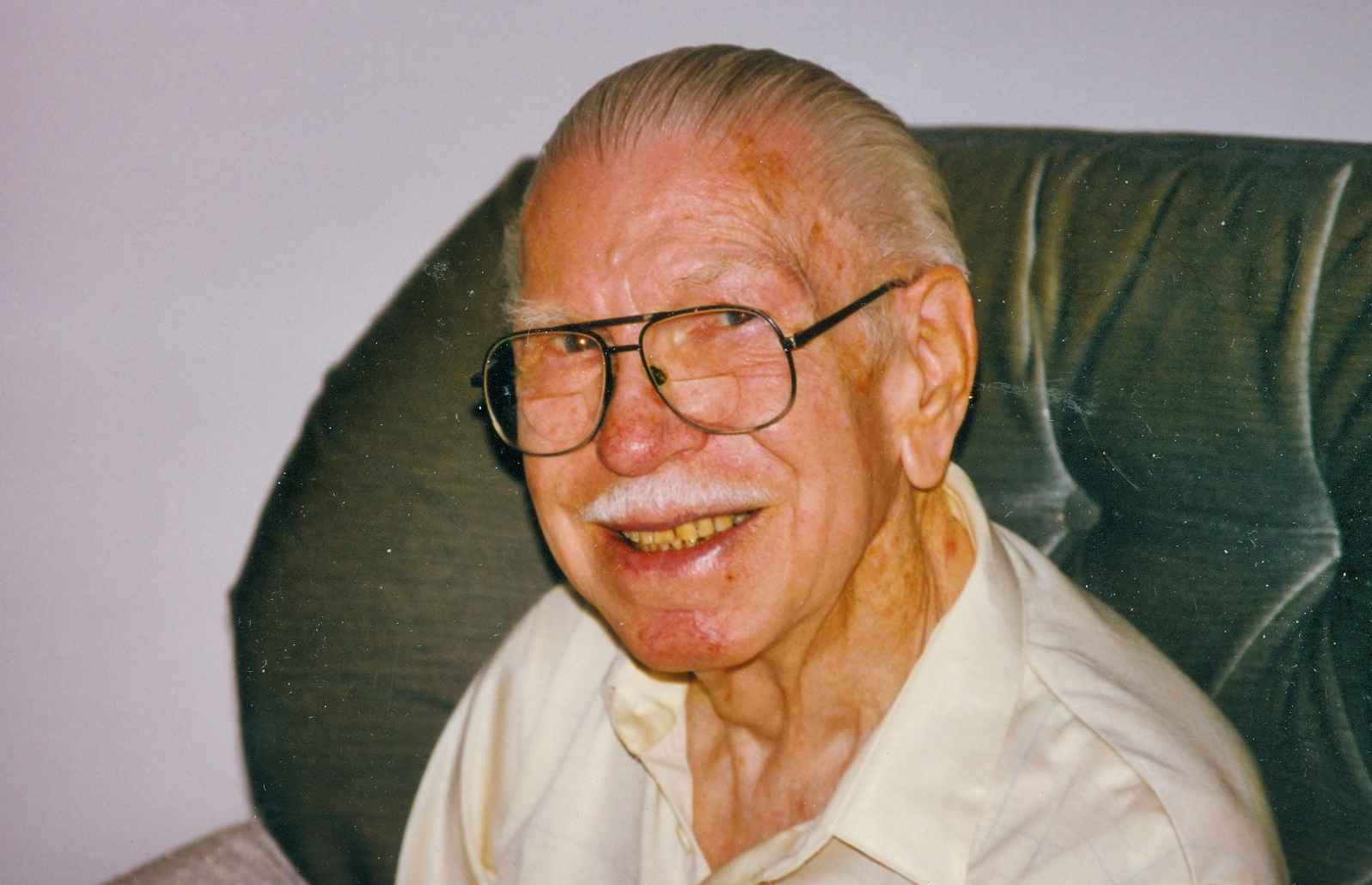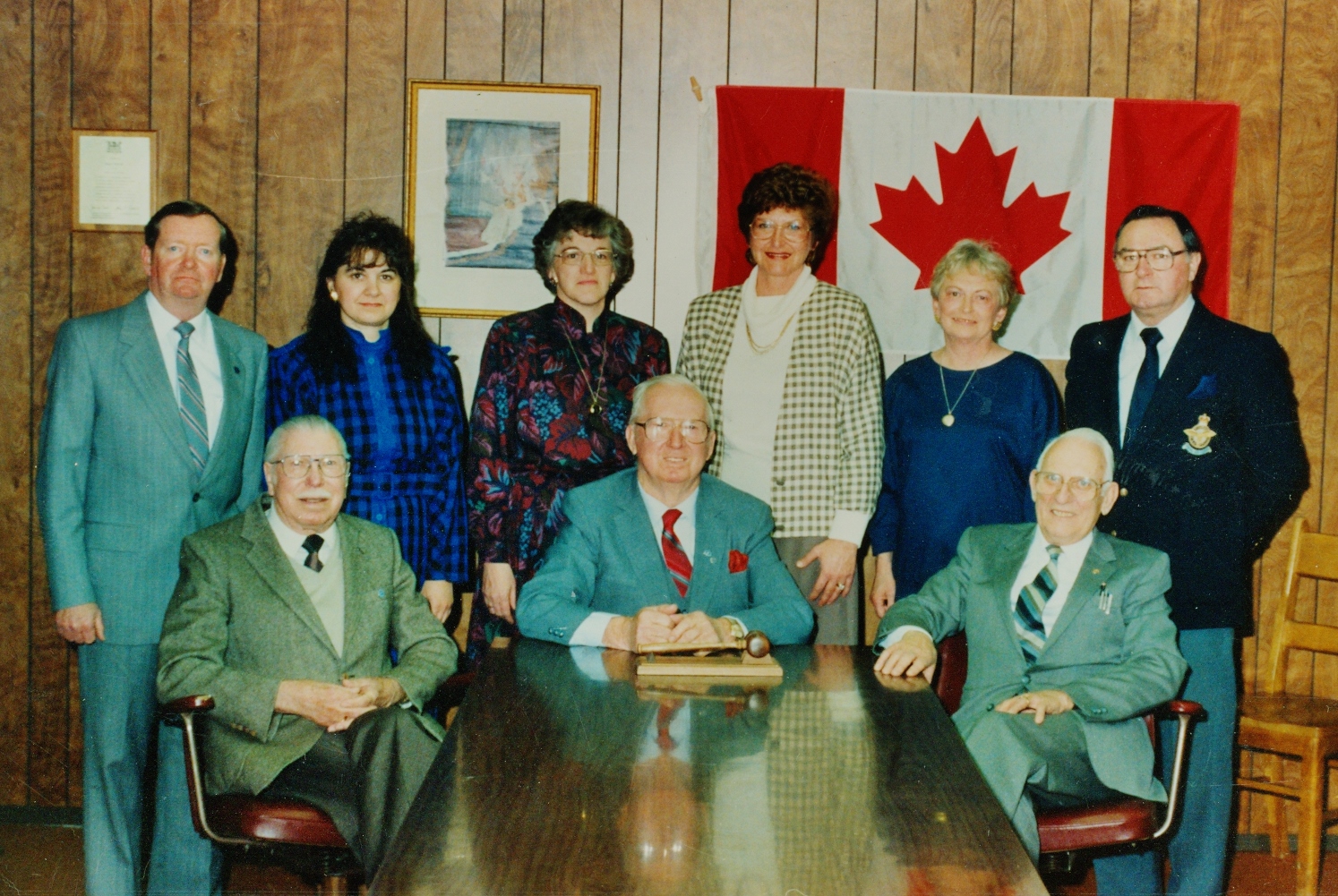1934 The Aces Band 1931 to 1939 Doug Hutchinson, jack grant, Fred Doris, Grey Kemp Roy Spalding and Larry Brown
JACK GRANT REMEMBERS
My family arrived in Marmora during the second week of September in 1915. My dad, Wesley Grant, had been a foreman at the Corundum Mines at Burgess Mines, a little hamlet in Wicklow Township. Their operations terminated in the winter of 1914-15 and dad came to Marmora in March of 1915, where he was employed by the Pearce Lumber Company in their Sash and Door Factory.
Although my father never had the opportunity of attending school, he was an excellent carpenter. He had learned to read and write while attending Sunday School in Maynooth. The rest of my family had wanted to move to Marmora in the spring of 1915, but my dad couldn't rent a house until September 15. The house he rented from the Pearce Company was number 20 on Main Street. We were right across the street from the grist mill.
So, in September we packed all of our worldly goods in a box car at Maynooth Station and came to Marmora. Our family then consisted of my dad, my mother, Annie Grant, my sister Emma, 18, my brother Frank, 15, and my brother Wilson, 12. My two older sisters, Mae and Georgina, were married and living in Boulter and Fort Stewart. I remember so well: we came by train to Marmora Station, my first trip on a train, and we were met by Bill Sanderson, who operated a livery service. He delivered our family to the St. James Hotel, now Havelock Auto Parts, where we stayed for two days and two nights, guests of Tom and Ada Potts. Mr. and Mrs. Potts were super people who treated us with much kindness. Mrs. Potts and my mother became very good friends from that first day and remained so during the rest of their lives.
My brother, Wilson, and I made a grand tour of the town on that first night. We could walk on the sidewalks, mostly wooden; see street lights for the first time; and the stores just dazzled us. More of that later. Wilson and Istarted school the following Monday. He had at- tended school in New' Carlow quite regularly, but I had only gone there for one year. It was five miles through the bush from Burgess Mines to the school at New Carlow, and mother wouldn't send me during the bad winter weather. Anyone who is living now in my age bracket could tell a lot about those cold, cold snowy winters in the 20's and 30's.
So I started to school in Marmora, 8-years-old, in the junior first class, absolutely terrified. I'm sorry that I can't remember my teacher's name, but she could instantly sense that I had a lot of catching up to do. She took me to the principal; Charlie Haig. He kept me after school and just asked me questions and talked to me,and I credit him for giving me the confidence I needed at such a critical time in my life.
St. Andrew's Glee Club 1942, mother of Jack Grant in centre
Enough of personal history.
MARMORA 1915
In 1915 Marmora was a very busy little town. The Pearce Company operated the big saw mill at the dam. They also owned the sash and door factory, a woolen mill, and a small generating unit at the dam. Deloro Smelting and Refining Company was in full operations, with over 300 employees. In the spring and summer, the river above the dam was practically full of logs waiting to be processed. The road at the stave mill house, also known as the house with the chains around it -(presently owned by Mr. and Mrs. W.J. Cox) was our entrance to the sorting bays. The Pearce Company had three piers erected across the river with booms (logs chained end to end) stretching from these piers down river to the mill.
The logs coming down the river, mostly from Beaver Creek, were divided at the sorting gap. Softwood, pine,cedar, poplar, etc, were headed downstream in one channel, while the birch, maple, and oak were separated from the softwood and sent into another channel. We, (and some names come to mind: Ralph and Ky Neal, Gerald Potts, Mickey McWilliam, Ken Simmons, Norman Narrie, Gordon Knox, Gordon Gray, Leo and Lome Forestall, Bill Bonter, Harold Auger, Chuck Brady and Percy Archer), were just who considered the sorting gap our favourite swimming place.There were lots of black snakes then and the old snapper, but we were never bothered by them. I must say, however, we respected the snapper turtles.
On Main Street were two blacksmith shops -- Ben Osborne and Mike Doupe --both excellent with horses and considered the best in the area. There was also a carriage repair shop operated by Jim Gehan. I went through his yard every morning on the way to school and he always had time to wish me a good morning and give me a pat on the back.
Clarence Gladney had the big general store on the corner, now Lynch's' ice plant and frozen foods. Next was the little office of Mr. McQueen. I believe he was an accountant arid did a lot of work for the Pearce Company. Then there was Charles Bleecker's office. He sold insurance, was very active in town politics, and was a retired army officer. Next was the telephone office, operated by Miss Foley with help from Flossie Boyd. Next door, Violet Deacon had a millinery shop with all the latest fashions in ladies hats. The Herald office, owned by Mr..Sabine, was on McGill Street. Now it is an.apartment building. My sister Emma worked at the Herald office.
Cash Boyd operated a men's fashion store on the corner, now the Cutting Corne rhair salon.Then came the Royal Hotel, operated by Till Neal. There was Marrin's Drug Store; then F.N. Marett's store, the only original business in Marmora that has been serving the public since the early 1900's.
Don Marett told me that he thought his dad was doing business in Marmora in1906 or 1907. Bill Marett and his wife, Pat, are the present owners, and personally, it's a pleasure to shop there. The next building south contained Dan Shannon's hardware store and post office, administered by one Evelyn (Ev) Shannon,
Then there was Nina Pinner's jewellery store, which Cook's Barber Shop now occupies, and where the pharmacy is now was Fred Lee's Harness Shop and Shoe Repair. The next building contained the Dunlay Brothers' men's store and the Dominion Bank, and on the corner was Connor and Jones Hardware, where our bank now operates.
South across the street, now Highway 7, was Dr. Thomson's big yellow house, with beautiful lawns on both the west and north sides. This is now the location of the post office and Mac's Milk Store. On the west side of Forsyth Street, the first business was Wm Sweet and Sons Bakery; now Cassidy's Furniture Store. Next, the brick house, now the office of Dr. Dosaj; then Dr. Crawford's house, now occupied by Dr. Parkin. The next building, now the Coach light Restaurant, was Donnelly's Barber Shop and Pool Room. I remember Mr. Donnelly had several Boston bulldogs on the premises.
JACK GRANT - THE MUSICIAN
Annie peeverGrant, mother of Jack Grant, 1898, with Mae Grant, Georgina Grant and Emma Grant
The above photo was mis-labelled. According to David Slade, this is a photo of his grandfather, Frank Grant and H. Wright
Jack Grant 1930
" I started to play the bones when I was 12. A show came to Marmora, a minstrel show and one of the guys, they called him Mister Bones and he played the bones and after the show I was so intrigued I went up and said "How do you play those?" and he showed me. He said "Do you like music?" "Oh ya," I said and he said, "Well, if you can get a set of bones, you'll have a lot of fun," and I've had these (bones) for 50 years."
THE GRANT FAMILY
Burgess Mine
Wicklow Township
May 21, 1913
Wesley and Annie Grant
Georgina 18
Emma 16
Frank 13He is Betty Slade's father
Wilson 8
Jack 6
MEMORIES:
Shannon Thomson: Georgina Grant would be my daughter, Georgina's, great great great grandmother♡
Betina Roberts: My Nan, Sheila, has a photograph of Annie who would be my third great grandmother and it's looks as though it was taken on the same day
Sharon Anne Vesterfelt : My grandmother, Georgie, was the eldest, who married Thomas Wilson Campbell. After his death she remarried years later to Wallace McInroy. Both incredible men!









































